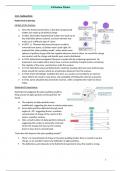3.8 Nuclear Physics
3.8.1. Radioactivity
Rutherford Scattering:
Models of the Nucleus:
1. Since the Ancient Greek times, it had been proposed all
matter was made up of identical lumps.
2. In 1803, John Dalton hypothesised matter was made up of
tiny indivisible spheres (atoms), and each element was
made up of a different type of ‘atom’.
3. In 1897, J.J. Thomson discovered electrons could be
removed from atoms, so Dalton wasn’t quite right. He
proposed the ‘plum pudding model’, where atoms were
spheres of positive charge with tiny negative electrons stuck in them, so overall the charge
was neutral, and the charge and density were evenly distributed.
4. In 1909, Rutherford investigated Thomson’s model with his scattering experiment. He
proposed a new model where atoms have a central, positively charged nucleus containing
the majority of the mass, and electrons orbit the nucleus.
5. In 1913, Neils Bohr improved Rutherford’s model by showing electrons have shells/energy
levels around the nucleus which are at particular distances from the nucleus.
6. In 1926, Erwin Schrödinger modelled the atom as a nucleus surrounded by an electron
cloud. Where the cloud is most dense, the probability of finding the electron is greatest.
7. In 1932, James Chadwick discovered the neutron, which completes the model we know
today.
Rutherford’s Experiment:
Rutherford investigated the plum pudding model by
firing a beam of alpha particles at thin gold foil. He
found:
A. The majority of alpha particles were
undeflected, suggesting the atom is mainly empty space.
B. Some alpha particles deflected through small
angles of <10°, suggesting there’s a positive
concentration of charge at the centre of the
atoms, a positive nucleus.
C. Only a small number of alpha particles rebound,
suggesting the nucleus is extremely small and
where the charge and mass (as the nucleus
doesn’t move too) is concentrated.
“How does this disprove the plum pudding model?”
There’s no concentration of charge in the plum pudding model, there is overall a neutral
charge, so we wouldn’t expect any deflection of alpha particles.
The deflections and rebounds in the Rutherford experiment show the model is wrong.
1
, α, β and γ Radiation:
If any of these types of radiation hit other atoms, they can knock out electrons, ionising the atom.
This can cause chemical changes in materials and can damage or kill living cells.
Alpha Radiation:
Alpha particles are high energy particles made up of 2 protons and 2
neutrals (a helium nucleus).
They’re emitted from nuclei too large.
It’s the most ionising as it has the highest charge (+2e), so it does more damage to cells.
It’s the least penetrating so it travels the shortest distance in air before being absorbed.
It can be stopped by paper.
Beta Radiation:
Beta particles are high energy electrons/positrons emitted from the nucleus.
β- are emitted by nuclei with too many neutrons. β+ are emitted by nuclei with
too many protons.
It’s moderately ionising due to its charge of +1e, so it does slight damage to cells.
It’s moderately penetrating.
It can be stopped by a few millimetres of aluminium.
Gamma Radiation:
Gamma rays are high energy electromagnetic waves.
They’re emitted by nuclei that need to lose some energy.
It’s the least ionising as it is an EM wave with no charge. It can still cause damage
to cells, but not as much as alpha or beta, so it’s used for cancer radiotherapy.
It’s the most penetrating as it has an infinite range and follows an inverse square
law.
It can be stopped by several metres of concrete or several centimetres of lead.
Smoke Detectors: Thickness Controls:
1. These contain a weak alpha source. It has a 1. Beta radiation is used to determine the thickness of
long half-life, so over the course of a aluminium foil, paper, plastic and streel. Beta is
lifetime, the activity of the source won’t used as alpha particles would be absorbed by every
decrease significantly so it doesn’t have to material, and gamma would pass through the
be replaced. materials undetected. It has a long half-life, so it
2. Alpha particles are emitted and ionise the doesn’t need to be replaced often.
air. 2. The amount of beta radiation that passes through
3. These ionised molecules allow the air to the material is measured by a Geiger counter.
conduct electricity, so a small current flows. 3. The Geiger counter controls the pressure of the
4. If smoke enters the alarm, the current is rollers to maintain the correct thickness.
reduced causing the alarm to sound.
2




